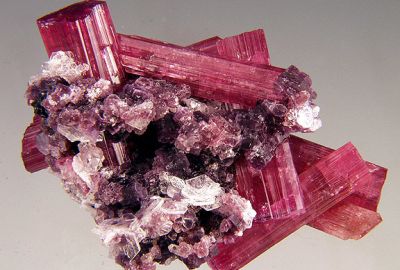Pink Tourmaline

In the Sinhalese language of the Sinhala peoples of Sri Lanka we find the word "Thora-mali" or in the Tamil language "Turava mali" which characterized all the crystalline stones, tourmaline, zirconia, sapphire emerald etc. In the process, the name prevailed for the cyclosilicate transparent mineral with very strong colors and dozens of shades. An old Sinhalese legend says that Tourmaline, on her way from the center of the earth to the surface, fell in love and joined the God Rainbow. When Rainbow ascended to heaven, he donated his colors to his beloved Tourmaline, a sign of love and the union of the earthly with the heavenly.
The mineral family called tourmaline is one of the most chemically complex mineral families. It is structured like a crystal in the triangular crystallization system, such as corundum (ruby, sapphire) and quartz. It has a hardness of 7.5 on the Mohs scale and 3.6 specific gravity. Characteristic of the stone is piezoelectricity, the property of tourmaline to generate electrical voltage through mechanical pressure or oscillation. The friction of the stone, especially on woolen cloth, magnetizes the ash, and was one of the oldest ways used by ancient merchants and artisans to tourmaline.
The Spanish and Portuguese conquistadors (conquerors) returned to their homelands with green, pink and red tourmaline crystals and for years believed they were rubies and emeralds.
The confusion over the of the stone continued with the settlement in Sri Lanka, then Ceylon of Dutch merchants, who out of ignorance gave the name "thora mali", meaning "various stones" in the local language.
Many of the emeralds in ancient Egyptian jewellery are actually green tourmalines, either olivines or elvites.
The colours of tourmaline or the place of origin, give the name to the varieties of the stone. Colorless achrochite, olivine, vertelite and elvaite, with deep green color, iron-rich schorlite black tourmaline, indicolite blue tourmaline, dravite dark chestnut colour tourmaline, and of course watermelon tourmaline, exceptional beautiful tricolor stone, made of green white and pink tourmaline The pink tourmaline belongs to the Rossmanites, or the Rubellites, two varieties with the main characteristic the pink to red color of the stone.
Many of the stones that adorned the jewellery of the Tsar's Treasure, while believed to be rubies, are actually pink and red tourmalines, of exceptional clarity and color.
It was not until 1800 that the tourmaline family was categorized based on the unusual triangular structure of its crystals, and took its place on the gemological map.
In India and Ceylon it was one of the favorite stones of the caste (class) of merchants and middle-ranking government officials
The Chinese have loved tourmaline for a long time. The Widow Empress Tzu Hsi who ruled China from 1860 until her death in 1908, loved the pink and red tourmalines, which soon became China's favorite stones. During the same period in Maine, USA and in San Diego, California, the extraction of red and pink, mainly tourmaline, created thousands of jobs and great wealth. Almost all of the production traveled to China, but the change of government in Beijing in 1912 zeroed in on imports, creating in 1915 the Big Tourmaline Crash in California.
Mines with large quantities of tourmaline opened in Brazil in 1920-30, while in 1950, Madagascar joined the mining countries with high quality pink tourmaline, and excellent watermelon tourmalines.
Today, Brazil is the largest tourmaline mining country, with mines in Minas Gerais, and Paraiba, Africa Afghanistan, Pakistan, Madagascar, Mozambique, India, Burma, Sri Lanka, Australia, Canada are the countries where tourmaline is exported. aims.
Pink tourmaline is the stone of the heart chakra (Anahata Chakra). Reflecting the inner light strengthens the energy field. Enhances love and companionship. In Feng Shui, it is the stone of fire and earth, we place it in the south or southeast bagua (Extreme) for help in work and career, or for understanding and love in It is a Libra stone, with influences on the winter signs Capricorn, Aquarius and Pisces.

 Ελληνικά
Ελληνικά  English
English